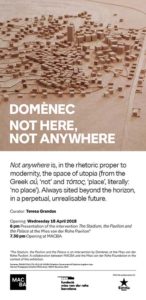Being from a place that no longer exists and even being born and dying in a place that no longer exists. Being from a place which, according to official maps of the State of Israel, never existed. They keep the keys to the houses, but they are keys that no longer open any door.
Hundreds of thousands of Palestinians are trapped in limbo1 This limbo has different names such as Arrub, Kalandia, Camp No. 1, Balata, Shu’fat, or Far’a on the West Bank; Jabalia, Rafah, or Beach in the Gaza Strip or the infamous Shatila in Lebanon… and one sole status: Refugee camps under the administration of the UNRWA (United Nations Relief Work Agency)2. This limbo is shaped like a labyrinth in which the refugees are born, live and die trapped in this labyrinth. They have been there for about 60 years and are unable to find the way out.
Living in a refugee camp is the closest thing to living in a permanent No Place, a space suspended in a suspended time, designed and constructed to give temporary shelter to the displaced, with a defined and non-expandable perimeter, and in the early days they were tent camps designed for a short time, for a few months, maybe a few years.
Palestinian refugees lived ten or twelve years in these tents waiting to return to their homes, but this return never arrived, and gradually these tents were replaced by small self-built homes, no one designed a development plan, no one drew any squares or streets, and there are only narrow, dark passageways between them, narrow defiles where one must walk in a single line; and the years kept passing, twenty, thirty, forty… and the population increased but the perimeter of the camp did not, and the houses had to expand by adding more rooms, and these began to grow in height, with new buildings being added on roofs and soon others appeared above them.
Human beings who have become the hostages of history live, are born and die in a transit area. Like a science fiction film they live in a parallel reality. When a child is born in Shu’fat refugee camp (on the outskirts of East Jerusalem), a strange phenomenon occurs: they are not really born there, but are born in Beit Natif, or in Lifta, although for the last 60 years Lifta has simply been a pile of rubble on the outskirts of West Jerusalem. When you ask a girl in Balata camp where she is from, she will tell you without a second’s hesitation that she is from Ras Al al-Ayin or Al-Shaykh Muwannis, although if you search for these villages on a map, you’ll never find them.
A woman who has been a refugee in Balata camp for over fifty years, describes in great detail the family home in Jammasin Al Garbiye while showing us dozens of documents proving ownership; she says: “in front of the house was a big tree… and it’s still there!”. There, -now on the outskirts of Tel Aviv, there is nothing, no house or tree, only puddles and cranes and a few metres away two skyscrapers under construction designed by Philippe Stark.
Drinking coffee with a dead man
In the Palestinian refugee camp of Far’a on the West Bank, we were having coffee with a dead man “I’m dead, I’ve been dead for 60 years. If someone takes away your land, they take away your dignity, and a person without dignity is a dead person” he told us at the end of the conversation. We were there to videotape their memories3; for a couple of hours he and his wife had told us where and how they lived before 1948, before disaster befell, the Nakba4. They remembered everything: the house, the river, the cultivated fields, tomatoes, cucumbers, eggplants… and how they were forced to leave, and when they soon reached Far’a where they lived ten years in a tent, then in a shack -now it looks something like a home- and 60 years have passed, 60 years waiting to return to cultivated fields near the river where tomatoes, cucumbers, and eggplants grew… “the only option is to return!” he insisted again and again. A few days later we went there: there were no cultivated fields or tomatoes or eggplants; the river was there however flanked by a pleasant urban park, the Yarkon Park, which crosses from east to west, north of Tel Aviv, it was Saturday and dozens of carefree citizens were practising sports, strolling or playing with their children without realizing the presence of their neighbours: the dead man who was drinking coffee and his wife who, despite not moving from the Far’a refugee camp in 60 years, have never stopped growing tomatoes and eggplants in this place.
Jerusalem, 2007
Annotations:
(1) Limbo: according to Catholic theology, limbo is a state, or a place on the edge of hell, where those who committed no sin themselves would bear the guilt of original sin.
(2) According to the latest census there are 4,448,430 Palestinian refugees scattered among the Occupied Palestinian Territories, Jordan, Syria and Lebanon. Approximately one-third (1,300,000) live in 58 refugee camps managed by UNRWA.
(3) 48_nakba: Video, 22’. Israel / Palestine 2007. Images, script and direction: Domènec and Sàgar Malé. Participants: Refugees in Ramallah and the refugee camps of Al Fara’a and Balata. A documentary film by Mapasonor
(4) The Palestinians use the word Nakba, which in Arabic literally means “catastrophe” to describe the war following the proclamation of the State of Israel in 1948 and which resulted in the pillaging and forced exile of some 750,000 Palestinians, hundreds of villages being demolished and their names eliminated from maps. Since 1998 Palestinians have “celebrated” the day of the Nakba on May 15, the same day the Israelis celebrate the day of the declaration of independence of the State of Israel.
